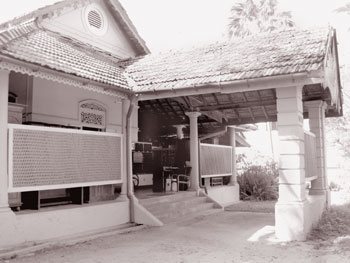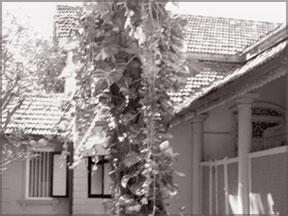Past glamour
The house Sir John's grandfather built:
by Aditha Dissanayake
A carriage drawn by two horses stops at the front porch. The door
opens. A lady dressed in a white long-sleeved blouse, and a flowing
green skirt gets off, looks at me and gives me a welcoming smile.
"Have you come to write about us?" she asks me. Before I can answer I
hear footsteps behind me. Slippers dragging on the cement floor.
"Mahaththaya will be with you in a minute" says the figure dressed in
a sarong and white-shirt and retreats back into the dark interior of the
house. I turn once more towards the porch to see if the lady is still
there. No, she had vanished as mysteriously as she had appeared.
|

One of the oldest houses in the country |
Had she been there, I would have told her "Yes, I have come to write
about you".
Though I have never seen Mrs. Alice Kotelawala, this is how I
imagined she would have looked way back in 1897, when she used to live
here, in this house, surrounded by a garden filled with araliya trees
and the eternal sound of the sea providing background music. In this
very garden, on a morning like this she would have walked with her new
born baby in her arms, pointing out a butterfly to him, or drawing his
attention to the chatter of a squirrel on a breadfruit tree.
"Yes" says Sidat Sri Nandalochana, who joins me on the porch, (true
to his butler's words, in exactly five minutes) confirming my imaginary
ramblings are not, totally imaginary after all. "This house was given to
Mrs. Alice Kotelawala as a part of her dowry. This is where Sir John
Kotalewala was born".
Things had been different, those days, naturally; Vajira Road for
example had been so narrow a car could barely move along it.
There had been only this house on this particular piece of land owned
by the Kotelawala family. Later on, the firm called Kotelawela Estates
Limited of which Sir John was Chairman, had built cottage-type houses
with two bedrooms, named after a variety of flowers; rukkathana, araliya,
manel.

The first house built thus was christened Nelum. " My father D.N.W de
Silva moved into this house called Nelum which was at the top of this
lane" recalls Nanda lochana.
"After sometime, as our family began to grow, Sir John summoned my
father and suggested "your children are growing up. Why don't you move
to a bigger house". This was how the present occupier, Sidat Sri
Nandalochana had stepped into No. 9, in Asoka Gardens, Bambalapitiya. "I
have been here from day one, when my family shifted here" he says and
tries to remember the year. 1946?
But the story does not end there. Realizing life may not be all that
cosy, bringing up three children with a journalist's salary, for his
father worked for the Times of Ceylon, Nandalochana recalls how Sir John
had stepped in once more and suggested his father should obtain an
auctioneer's license.
Soon D.N.W de Silva had become a reasonably popular auctioneer. From
the floor to the roof, the house was filled with antiques whose values
were priceless. "When my father passed away I asked my mother to
continue the business.
At first she refused saying what nonsense, how can she do it? But
when I kept insisting she agreed to step into my father's shoes, and
became a very successful lady auctioneer."
Now that she is no more Nandalochana says, even though he is fully
occupied with his own profession he does his best to continue the
business, (D.N.W Auction House) his parents had started. Adhering to the
same standards whatever furniture he buys he makes sure they are not
polished because "The gloss dupes people".
Though most of the rooms are empty today, there had been a time when
the house had provided shelter to many a wandering scholar and artist.
"This was an open house. Whenever someone said to my parents we have
no place to stay in Colombo they were welcomed to stay with us. "Enna,
enna" said my parents."
Recalls Nandalochana. Among those who stayed with them were Shanthi
Kumar, Prince Gunasekara and W.M Tilakaratne. Former President, J.R
Jayewardene too had been a frequent visitor. So were Sagara Palansooriya
and M.S Themis.
With sparkling eyes, Nandalochana says even though his parents were
staunch supporters of the UNP, they were tolerant and very liberal
minded and allowed him to follow his own political beliefs.
Thus it was that the house became one of the head offices of the MEP
during the 1956 elections.
Retaining its past glamour, House No. 9, still stands as it was first
built, and can unarguably be considered as one of the oldest houses in
the country. If the walls, the white painted pillars, the red clay tiles
could speak they would have enough stories to cover this whole page and
more.
But alas, last Tuesday morning, all they did was gaze at me in
silence and as I left taking one last look at this house with a past, a
squirrel ran along the parapet wall saying something to me with great
urgency. Perhaps he was saying "Sir John fed titbits to my
great-great-grandfather, please write it down too". Perhaps...
[email protected]
|
